Health Status Indicators of Cultures in New Zealand | Report
VerifiedAdded on 2022/08/11
|10
|2181
|21
AI Summary
same as TMP_270220_349559_2_1203647
Contribute Materials
Your contribution can guide someone’s learning journey. Share your
documents today.
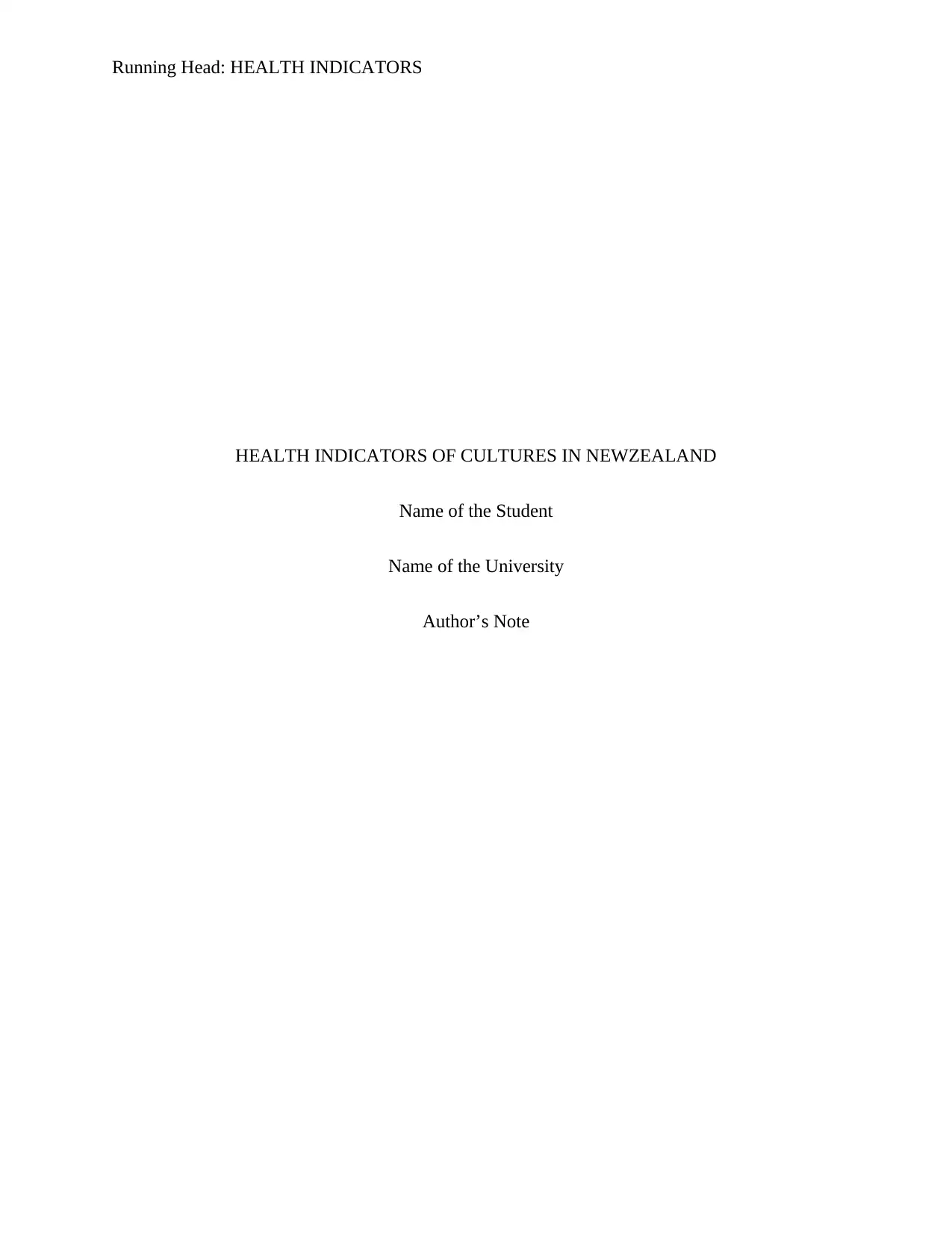
Running Head: HEALTH INDICATORS
HEALTH INDICATORS OF CULTURES IN NEWZEALAND
Name of the Student
Name of the University
Author’s Note
HEALTH INDICATORS OF CULTURES IN NEWZEALAND
Name of the Student
Name of the University
Author’s Note
Secure Best Marks with AI Grader
Need help grading? Try our AI Grader for instant feedback on your assignments.
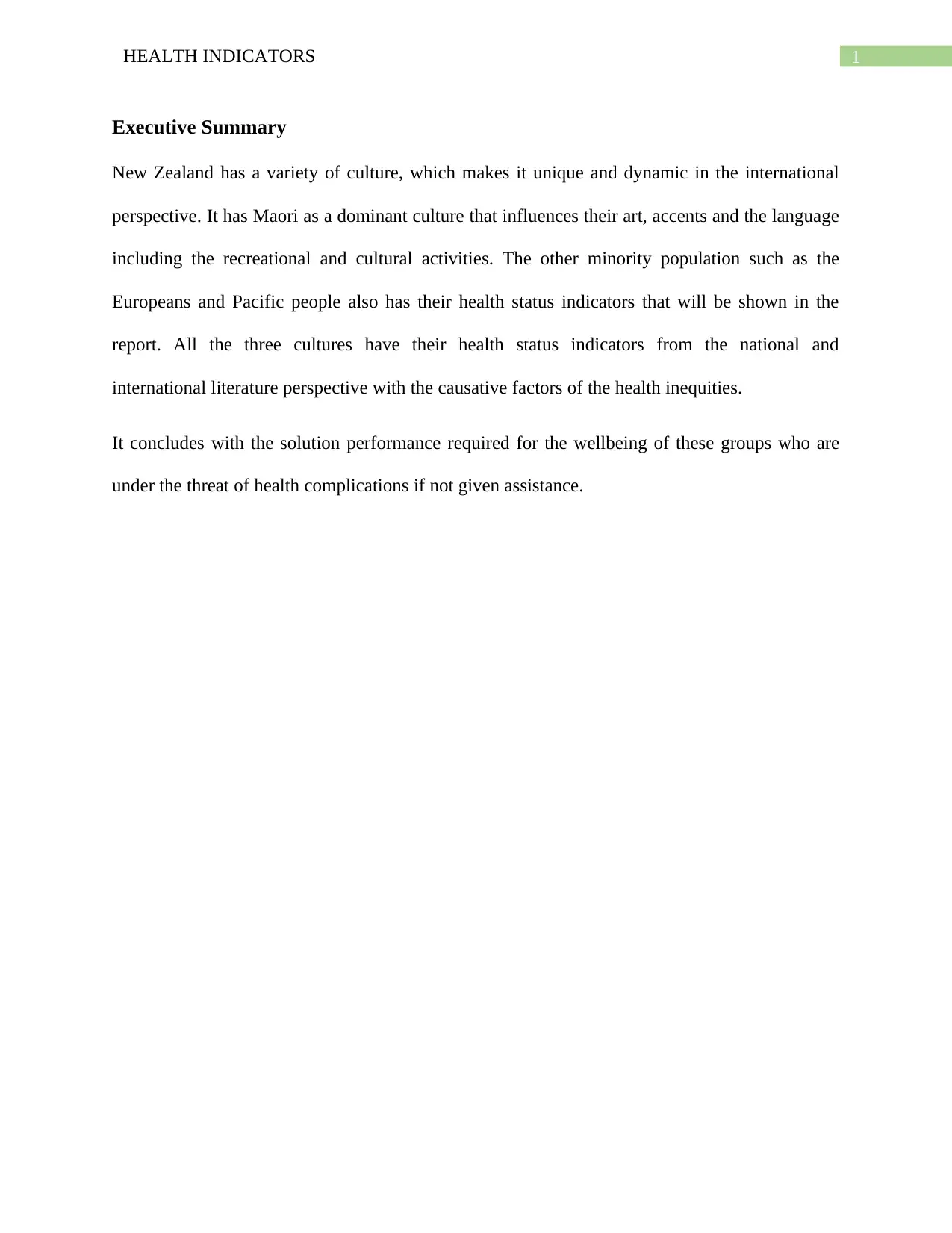
1HEALTH INDICATORS
Executive Summary
New Zealand has a variety of culture, which makes it unique and dynamic in the international
perspective. It has Maori as a dominant culture that influences their art, accents and the language
including the recreational and cultural activities. The other minority population such as the
Europeans and Pacific people also has their health status indicators that will be shown in the
report. All the three cultures have their health status indicators from the national and
international literature perspective with the causative factors of the health inequities.
It concludes with the solution performance required for the wellbeing of these groups who are
under the threat of health complications if not given assistance.
Executive Summary
New Zealand has a variety of culture, which makes it unique and dynamic in the international
perspective. It has Maori as a dominant culture that influences their art, accents and the language
including the recreational and cultural activities. The other minority population such as the
Europeans and Pacific people also has their health status indicators that will be shown in the
report. All the three cultures have their health status indicators from the national and
international literature perspective with the causative factors of the health inequities.
It concludes with the solution performance required for the wellbeing of these groups who are
under the threat of health complications if not given assistance.
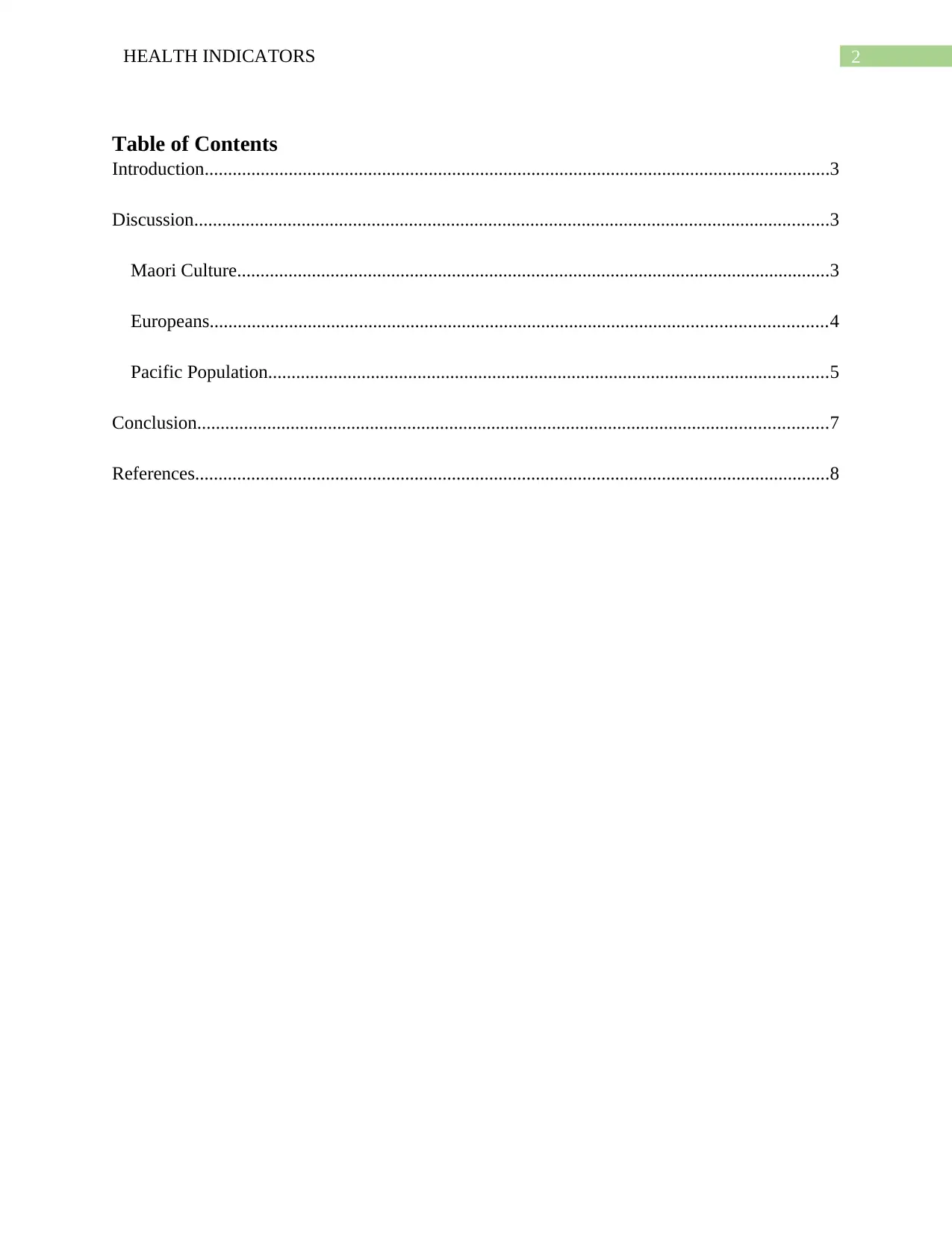
2HEALTH INDICATORS
Table of Contents
Introduction......................................................................................................................................3
Discussion........................................................................................................................................3
Maori Culture...............................................................................................................................3
Europeans....................................................................................................................................4
Pacific Population........................................................................................................................5
Conclusion.......................................................................................................................................7
References........................................................................................................................................8
Table of Contents
Introduction......................................................................................................................................3
Discussion........................................................................................................................................3
Maori Culture...............................................................................................................................3
Europeans....................................................................................................................................4
Pacific Population........................................................................................................................5
Conclusion.......................................................................................................................................7
References........................................................................................................................................8
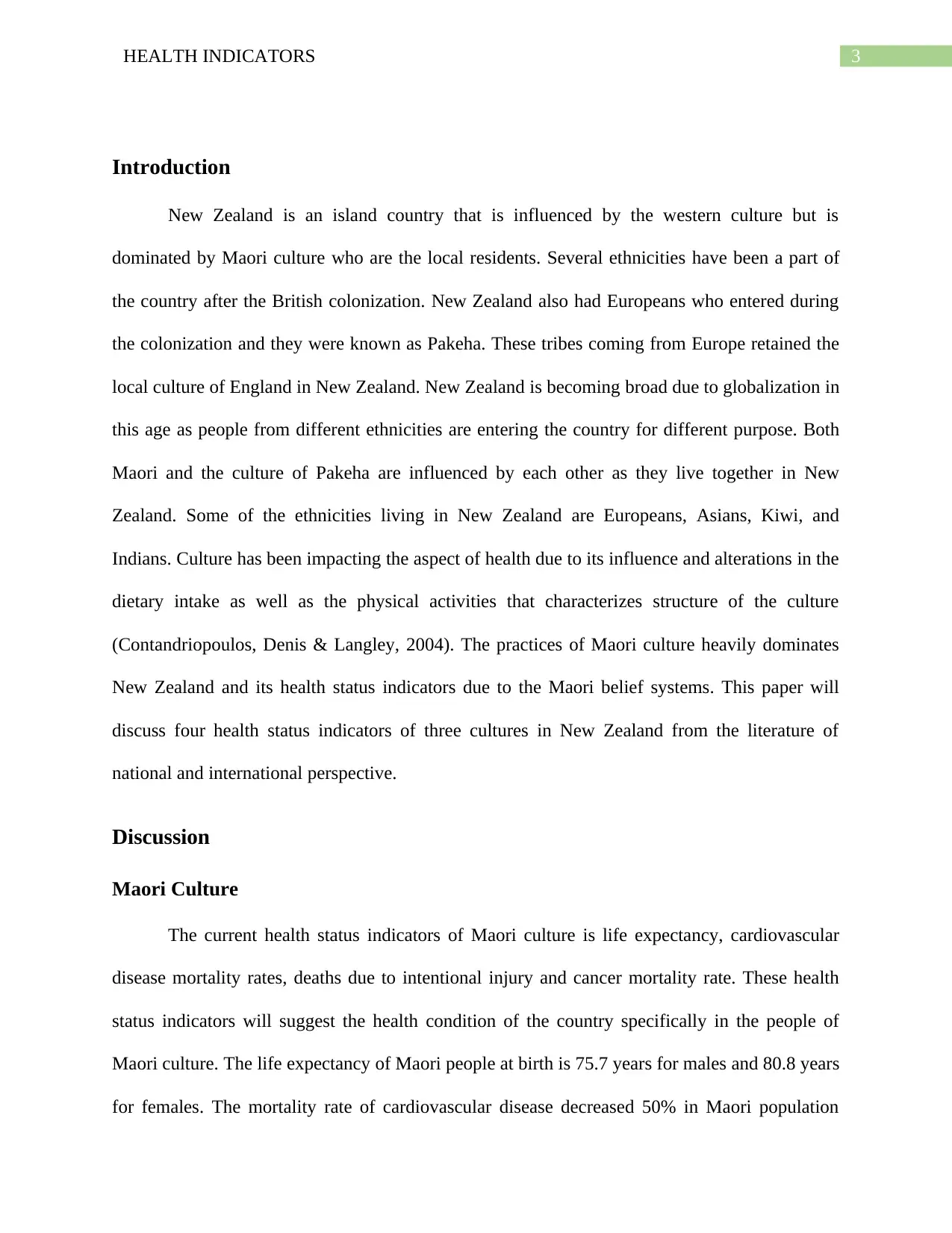
3HEALTH INDICATORS
Introduction
New Zealand is an island country that is influenced by the western culture but is
dominated by Maori culture who are the local residents. Several ethnicities have been a part of
the country after the British colonization. New Zealand also had Europeans who entered during
the colonization and they were known as Pakeha. These tribes coming from Europe retained the
local culture of England in New Zealand. New Zealand is becoming broad due to globalization in
this age as people from different ethnicities are entering the country for different purpose. Both
Maori and the culture of Pakeha are influenced by each other as they live together in New
Zealand. Some of the ethnicities living in New Zealand are Europeans, Asians, Kiwi, and
Indians. Culture has been impacting the aspect of health due to its influence and alterations in the
dietary intake as well as the physical activities that characterizes structure of the culture
(Contandriopoulos, Denis & Langley, 2004). The practices of Maori culture heavily dominates
New Zealand and its health status indicators due to the Maori belief systems. This paper will
discuss four health status indicators of three cultures in New Zealand from the literature of
national and international perspective.
Discussion
Maori Culture
The current health status indicators of Maori culture is life expectancy, cardiovascular
disease mortality rates, deaths due to intentional injury and cancer mortality rate. These health
status indicators will suggest the health condition of the country specifically in the people of
Maori culture. The life expectancy of Maori people at birth is 75.7 years for males and 80.8 years
for females. The mortality rate of cardiovascular disease decreased 50% in Maori population
Introduction
New Zealand is an island country that is influenced by the western culture but is
dominated by Maori culture who are the local residents. Several ethnicities have been a part of
the country after the British colonization. New Zealand also had Europeans who entered during
the colonization and they were known as Pakeha. These tribes coming from Europe retained the
local culture of England in New Zealand. New Zealand is becoming broad due to globalization in
this age as people from different ethnicities are entering the country for different purpose. Both
Maori and the culture of Pakeha are influenced by each other as they live together in New
Zealand. Some of the ethnicities living in New Zealand are Europeans, Asians, Kiwi, and
Indians. Culture has been impacting the aspect of health due to its influence and alterations in the
dietary intake as well as the physical activities that characterizes structure of the culture
(Contandriopoulos, Denis & Langley, 2004). The practices of Maori culture heavily dominates
New Zealand and its health status indicators due to the Maori belief systems. This paper will
discuss four health status indicators of three cultures in New Zealand from the literature of
national and international perspective.
Discussion
Maori Culture
The current health status indicators of Maori culture is life expectancy, cardiovascular
disease mortality rates, deaths due to intentional injury and cancer mortality rate. These health
status indicators will suggest the health condition of the country specifically in the people of
Maori culture. The life expectancy of Maori people at birth is 75.7 years for males and 80.8 years
for females. The mortality rate of cardiovascular disease decreased 50% in Maori population
Secure Best Marks with AI Grader
Need help grading? Try our AI Grader for instant feedback on your assignments.
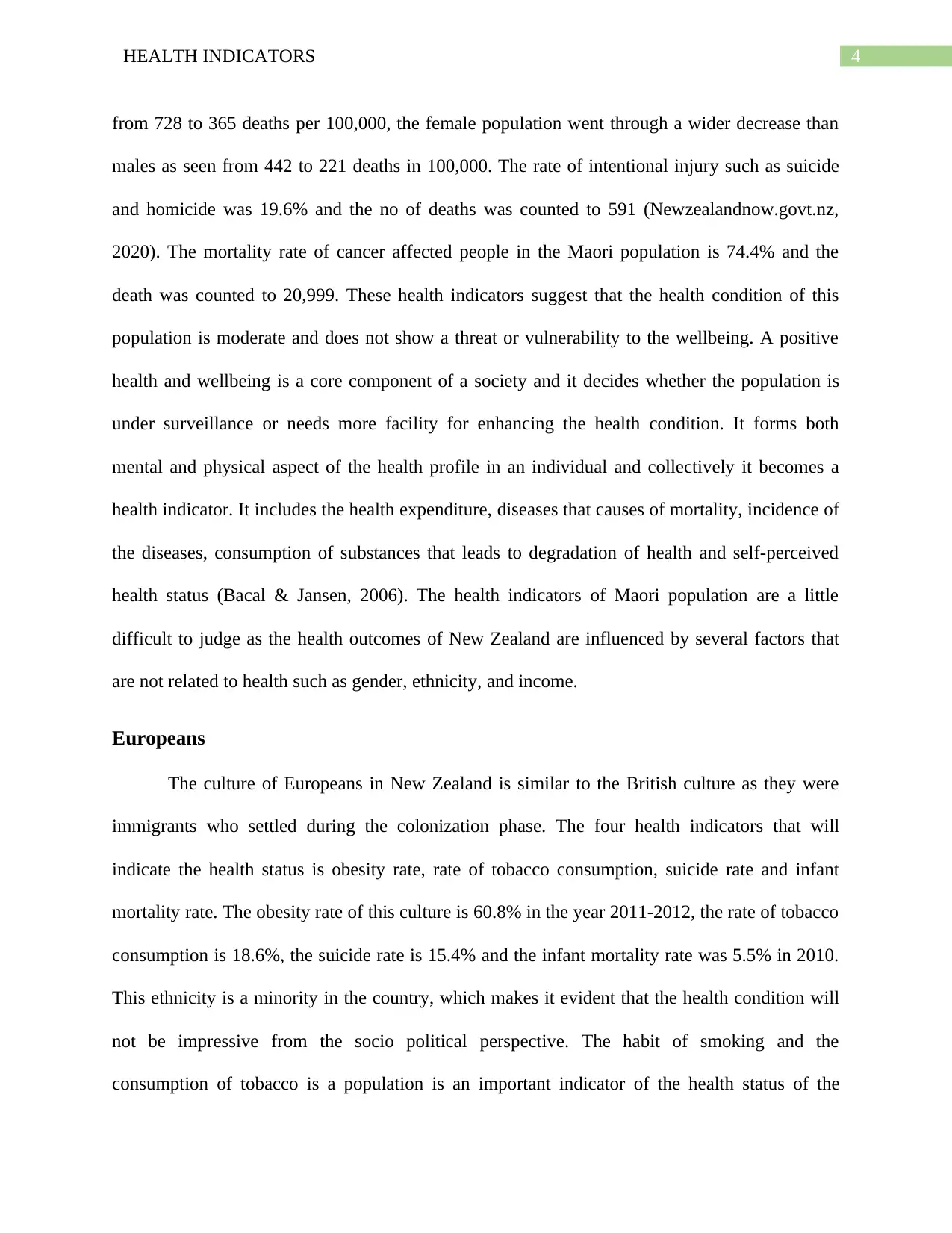
4HEALTH INDICATORS
from 728 to 365 deaths per 100,000, the female population went through a wider decrease than
males as seen from 442 to 221 deaths in 100,000. The rate of intentional injury such as suicide
and homicide was 19.6% and the no of deaths was counted to 591 (Newzealandnow.govt.nz,
2020). The mortality rate of cancer affected people in the Maori population is 74.4% and the
death was counted to 20,999. These health indicators suggest that the health condition of this
population is moderate and does not show a threat or vulnerability to the wellbeing. A positive
health and wellbeing is a core component of a society and it decides whether the population is
under surveillance or needs more facility for enhancing the health condition. It forms both
mental and physical aspect of the health profile in an individual and collectively it becomes a
health indicator. It includes the health expenditure, diseases that causes of mortality, incidence of
the diseases, consumption of substances that leads to degradation of health and self-perceived
health status (Bacal & Jansen, 2006). The health indicators of Maori population are a little
difficult to judge as the health outcomes of New Zealand are influenced by several factors that
are not related to health such as gender, ethnicity, and income.
Europeans
The culture of Europeans in New Zealand is similar to the British culture as they were
immigrants who settled during the colonization phase. The four health indicators that will
indicate the health status is obesity rate, rate of tobacco consumption, suicide rate and infant
mortality rate. The obesity rate of this culture is 60.8% in the year 2011-2012, the rate of tobacco
consumption is 18.6%, the suicide rate is 15.4% and the infant mortality rate was 5.5% in 2010.
This ethnicity is a minority in the country, which makes it evident that the health condition will
not be impressive from the socio political perspective. The habit of smoking and the
consumption of tobacco is a population is an important indicator of the health status of the
from 728 to 365 deaths per 100,000, the female population went through a wider decrease than
males as seen from 442 to 221 deaths in 100,000. The rate of intentional injury such as suicide
and homicide was 19.6% and the no of deaths was counted to 591 (Newzealandnow.govt.nz,
2020). The mortality rate of cancer affected people in the Maori population is 74.4% and the
death was counted to 20,999. These health indicators suggest that the health condition of this
population is moderate and does not show a threat or vulnerability to the wellbeing. A positive
health and wellbeing is a core component of a society and it decides whether the population is
under surveillance or needs more facility for enhancing the health condition. It forms both
mental and physical aspect of the health profile in an individual and collectively it becomes a
health indicator. It includes the health expenditure, diseases that causes of mortality, incidence of
the diseases, consumption of substances that leads to degradation of health and self-perceived
health status (Bacal & Jansen, 2006). The health indicators of Maori population are a little
difficult to judge as the health outcomes of New Zealand are influenced by several factors that
are not related to health such as gender, ethnicity, and income.
Europeans
The culture of Europeans in New Zealand is similar to the British culture as they were
immigrants who settled during the colonization phase. The four health indicators that will
indicate the health status is obesity rate, rate of tobacco consumption, suicide rate and infant
mortality rate. The obesity rate of this culture is 60.8% in the year 2011-2012, the rate of tobacco
consumption is 18.6%, the suicide rate is 15.4% and the infant mortality rate was 5.5% in 2010.
This ethnicity is a minority in the country, which makes it evident that the health condition will
not be impressive from the socio political perspective. The habit of smoking and the
consumption of tobacco is a population is an important indicator of the health status of the
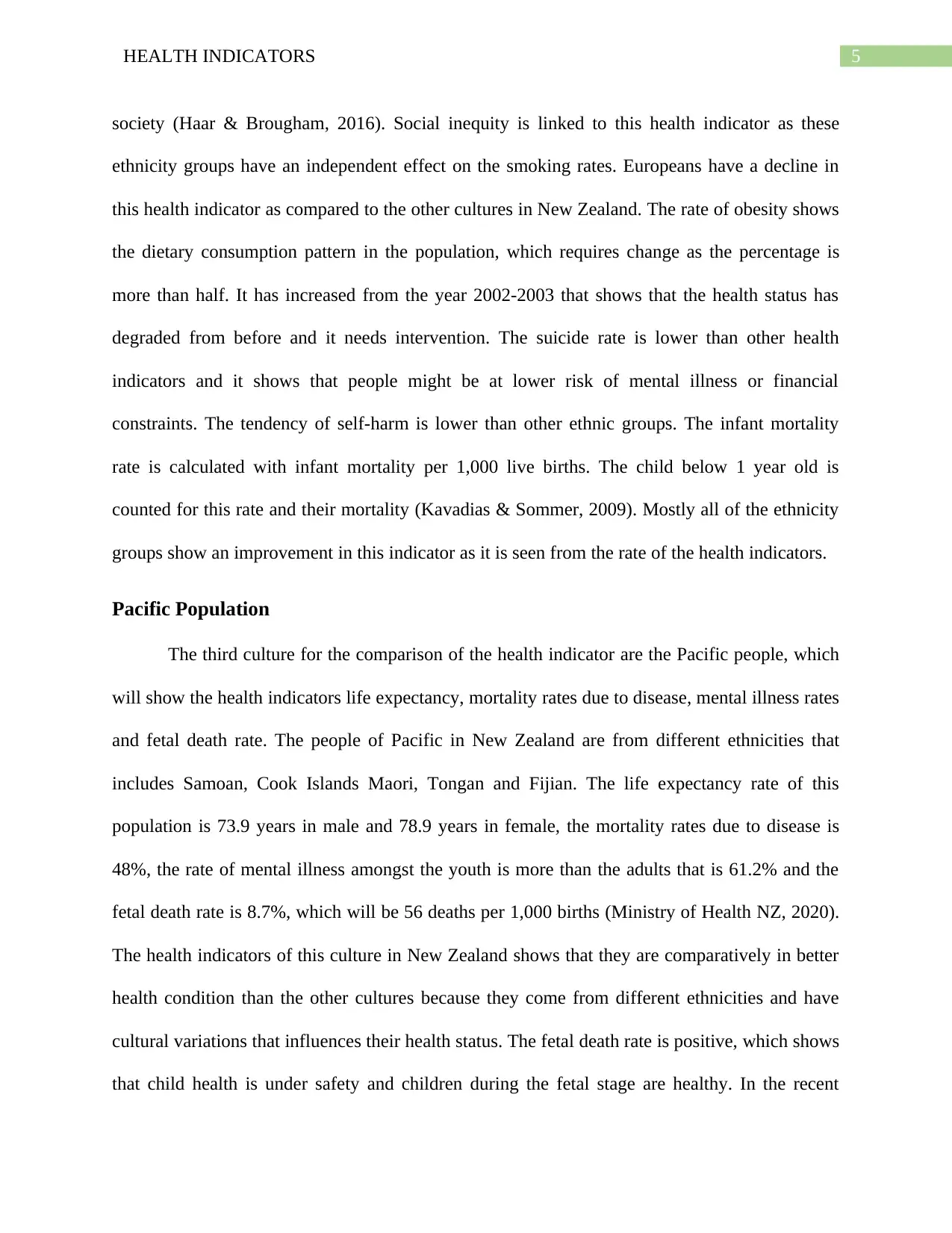
5HEALTH INDICATORS
society (Haar & Brougham, 2016). Social inequity is linked to this health indicator as these
ethnicity groups have an independent effect on the smoking rates. Europeans have a decline in
this health indicator as compared to the other cultures in New Zealand. The rate of obesity shows
the dietary consumption pattern in the population, which requires change as the percentage is
more than half. It has increased from the year 2002-2003 that shows that the health status has
degraded from before and it needs intervention. The suicide rate is lower than other health
indicators and it shows that people might be at lower risk of mental illness or financial
constraints. The tendency of self-harm is lower than other ethnic groups. The infant mortality
rate is calculated with infant mortality per 1,000 live births. The child below 1 year old is
counted for this rate and their mortality (Kavadias & Sommer, 2009). Mostly all of the ethnicity
groups show an improvement in this indicator as it is seen from the rate of the health indicators.
Pacific Population
The third culture for the comparison of the health indicator are the Pacific people, which
will show the health indicators life expectancy, mortality rates due to disease, mental illness rates
and fetal death rate. The people of Pacific in New Zealand are from different ethnicities that
includes Samoan, Cook Islands Maori, Tongan and Fijian. The life expectancy rate of this
population is 73.9 years in male and 78.9 years in female, the mortality rates due to disease is
48%, the rate of mental illness amongst the youth is more than the adults that is 61.2% and the
fetal death rate is 8.7%, which will be 56 deaths per 1,000 births (Ministry of Health NZ, 2020).
The health indicators of this culture in New Zealand shows that they are comparatively in better
health condition than the other cultures because they come from different ethnicities and have
cultural variations that influences their health status. The fetal death rate is positive, which shows
that child health is under safety and children during the fetal stage are healthy. In the recent
society (Haar & Brougham, 2016). Social inequity is linked to this health indicator as these
ethnicity groups have an independent effect on the smoking rates. Europeans have a decline in
this health indicator as compared to the other cultures in New Zealand. The rate of obesity shows
the dietary consumption pattern in the population, which requires change as the percentage is
more than half. It has increased from the year 2002-2003 that shows that the health status has
degraded from before and it needs intervention. The suicide rate is lower than other health
indicators and it shows that people might be at lower risk of mental illness or financial
constraints. The tendency of self-harm is lower than other ethnic groups. The infant mortality
rate is calculated with infant mortality per 1,000 live births. The child below 1 year old is
counted for this rate and their mortality (Kavadias & Sommer, 2009). Mostly all of the ethnicity
groups show an improvement in this indicator as it is seen from the rate of the health indicators.
Pacific Population
The third culture for the comparison of the health indicator are the Pacific people, which
will show the health indicators life expectancy, mortality rates due to disease, mental illness rates
and fetal death rate. The people of Pacific in New Zealand are from different ethnicities that
includes Samoan, Cook Islands Maori, Tongan and Fijian. The life expectancy rate of this
population is 73.9 years in male and 78.9 years in female, the mortality rates due to disease is
48%, the rate of mental illness amongst the youth is more than the adults that is 61.2% and the
fetal death rate is 8.7%, which will be 56 deaths per 1,000 births (Ministry of Health NZ, 2020).
The health indicators of this culture in New Zealand shows that they are comparatively in better
health condition than the other cultures because they come from different ethnicities and have
cultural variations that influences their health status. The fetal death rate is positive, which shows
that child health is under safety and children during the fetal stage are healthy. In the recent
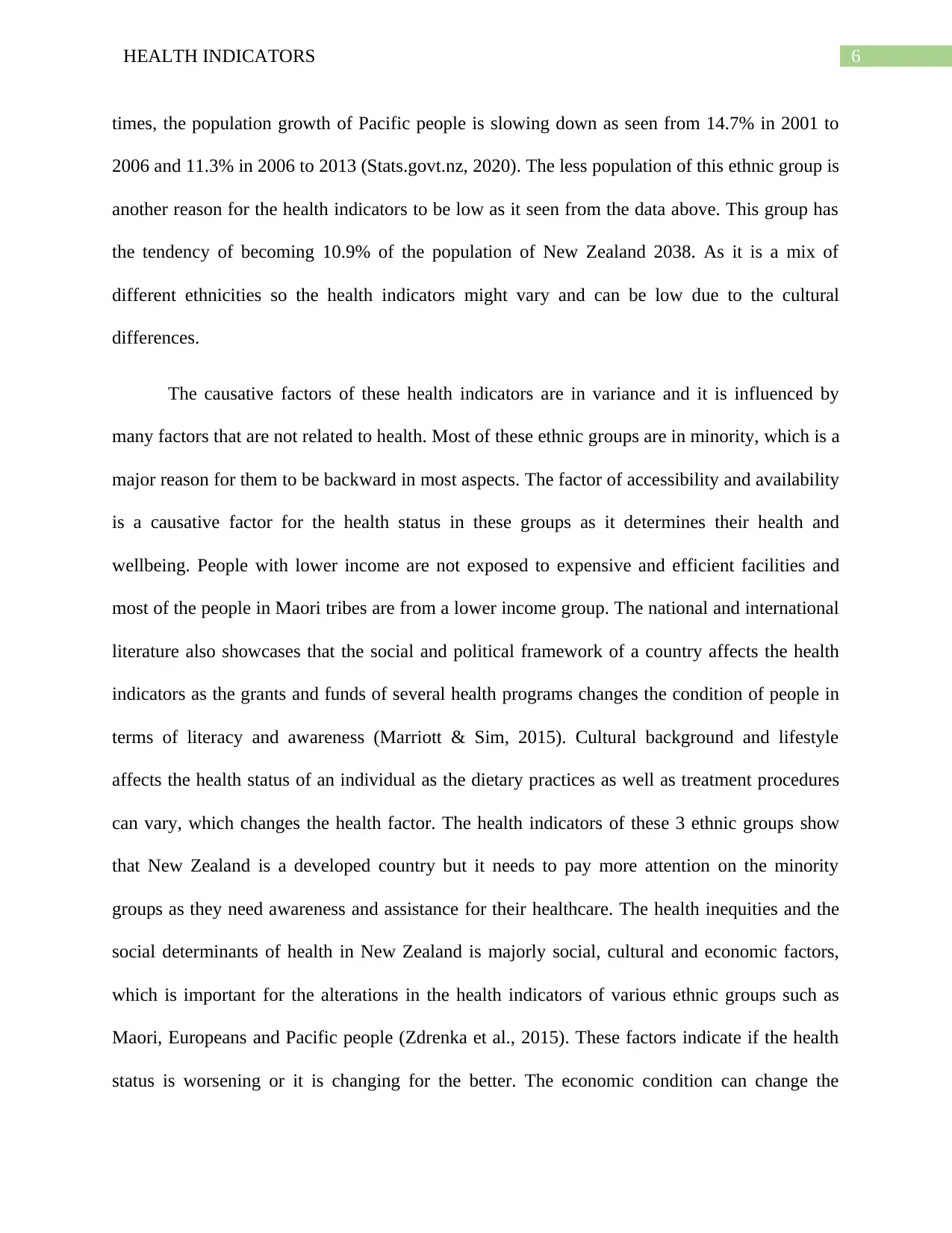
6HEALTH INDICATORS
times, the population growth of Pacific people is slowing down as seen from 14.7% in 2001 to
2006 and 11.3% in 2006 to 2013 (Stats.govt.nz, 2020). The less population of this ethnic group is
another reason for the health indicators to be low as it seen from the data above. This group has
the tendency of becoming 10.9% of the population of New Zealand 2038. As it is a mix of
different ethnicities so the health indicators might vary and can be low due to the cultural
differences.
The causative factors of these health indicators are in variance and it is influenced by
many factors that are not related to health. Most of these ethnic groups are in minority, which is a
major reason for them to be backward in most aspects. The factor of accessibility and availability
is a causative factor for the health status in these groups as it determines their health and
wellbeing. People with lower income are not exposed to expensive and efficient facilities and
most of the people in Maori tribes are from a lower income group. The national and international
literature also showcases that the social and political framework of a country affects the health
indicators as the grants and funds of several health programs changes the condition of people in
terms of literacy and awareness (Marriott & Sim, 2015). Cultural background and lifestyle
affects the health status of an individual as the dietary practices as well as treatment procedures
can vary, which changes the health factor. The health indicators of these 3 ethnic groups show
that New Zealand is a developed country but it needs to pay more attention on the minority
groups as they need awareness and assistance for their healthcare. The health inequities and the
social determinants of health in New Zealand is majorly social, cultural and economic factors,
which is important for the alterations in the health indicators of various ethnic groups such as
Maori, Europeans and Pacific people (Zdrenka et al., 2015). These factors indicate if the health
status is worsening or it is changing for the better. The economic condition can change the
times, the population growth of Pacific people is slowing down as seen from 14.7% in 2001 to
2006 and 11.3% in 2006 to 2013 (Stats.govt.nz, 2020). The less population of this ethnic group is
another reason for the health indicators to be low as it seen from the data above. This group has
the tendency of becoming 10.9% of the population of New Zealand 2038. As it is a mix of
different ethnicities so the health indicators might vary and can be low due to the cultural
differences.
The causative factors of these health indicators are in variance and it is influenced by
many factors that are not related to health. Most of these ethnic groups are in minority, which is a
major reason for them to be backward in most aspects. The factor of accessibility and availability
is a causative factor for the health status in these groups as it determines their health and
wellbeing. People with lower income are not exposed to expensive and efficient facilities and
most of the people in Maori tribes are from a lower income group. The national and international
literature also showcases that the social and political framework of a country affects the health
indicators as the grants and funds of several health programs changes the condition of people in
terms of literacy and awareness (Marriott & Sim, 2015). Cultural background and lifestyle
affects the health status of an individual as the dietary practices as well as treatment procedures
can vary, which changes the health factor. The health indicators of these 3 ethnic groups show
that New Zealand is a developed country but it needs to pay more attention on the minority
groups as they need awareness and assistance for their healthcare. The health inequities and the
social determinants of health in New Zealand is majorly social, cultural and economic factors,
which is important for the alterations in the health indicators of various ethnic groups such as
Maori, Europeans and Pacific people (Zdrenka et al., 2015). These factors indicate if the health
status is worsening or it is changing for the better. The economic condition can change the
Paraphrase This Document
Need a fresh take? Get an instant paraphrase of this document with our AI Paraphraser
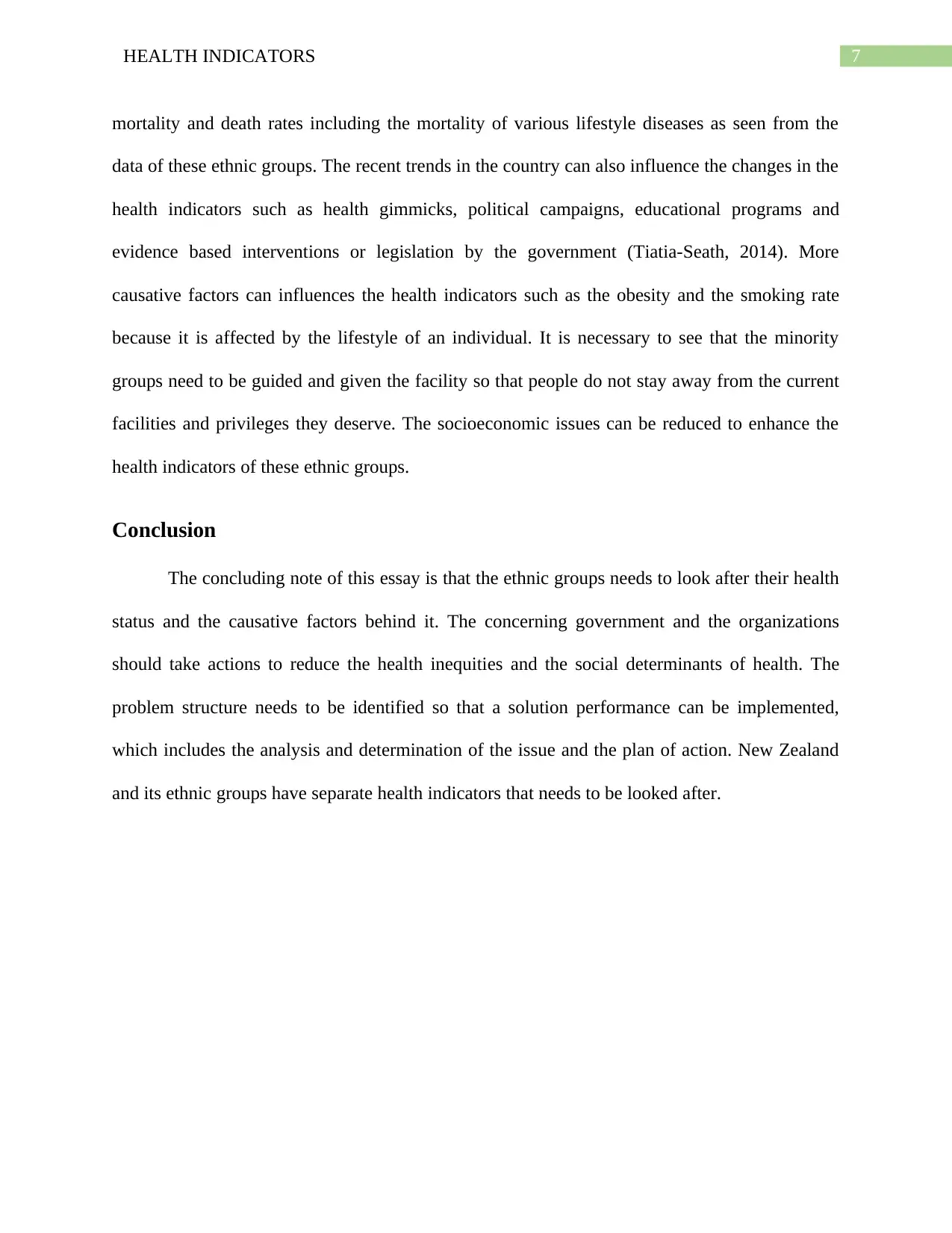
7HEALTH INDICATORS
mortality and death rates including the mortality of various lifestyle diseases as seen from the
data of these ethnic groups. The recent trends in the country can also influence the changes in the
health indicators such as health gimmicks, political campaigns, educational programs and
evidence based interventions or legislation by the government (Tiatia-Seath, 2014). More
causative factors can influences the health indicators such as the obesity and the smoking rate
because it is affected by the lifestyle of an individual. It is necessary to see that the minority
groups need to be guided and given the facility so that people do not stay away from the current
facilities and privileges they deserve. The socioeconomic issues can be reduced to enhance the
health indicators of these ethnic groups.
Conclusion
The concluding note of this essay is that the ethnic groups needs to look after their health
status and the causative factors behind it. The concerning government and the organizations
should take actions to reduce the health inequities and the social determinants of health. The
problem structure needs to be identified so that a solution performance can be implemented,
which includes the analysis and determination of the issue and the plan of action. New Zealand
and its ethnic groups have separate health indicators that needs to be looked after.
mortality and death rates including the mortality of various lifestyle diseases as seen from the
data of these ethnic groups. The recent trends in the country can also influence the changes in the
health indicators such as health gimmicks, political campaigns, educational programs and
evidence based interventions or legislation by the government (Tiatia-Seath, 2014). More
causative factors can influences the health indicators such as the obesity and the smoking rate
because it is affected by the lifestyle of an individual. It is necessary to see that the minority
groups need to be guided and given the facility so that people do not stay away from the current
facilities and privileges they deserve. The socioeconomic issues can be reduced to enhance the
health indicators of these ethnic groups.
Conclusion
The concluding note of this essay is that the ethnic groups needs to look after their health
status and the causative factors behind it. The concerning government and the organizations
should take actions to reduce the health inequities and the social determinants of health. The
problem structure needs to be identified so that a solution performance can be implemented,
which includes the analysis and determination of the issue and the plan of action. New Zealand
and its ethnic groups have separate health indicators that needs to be looked after.
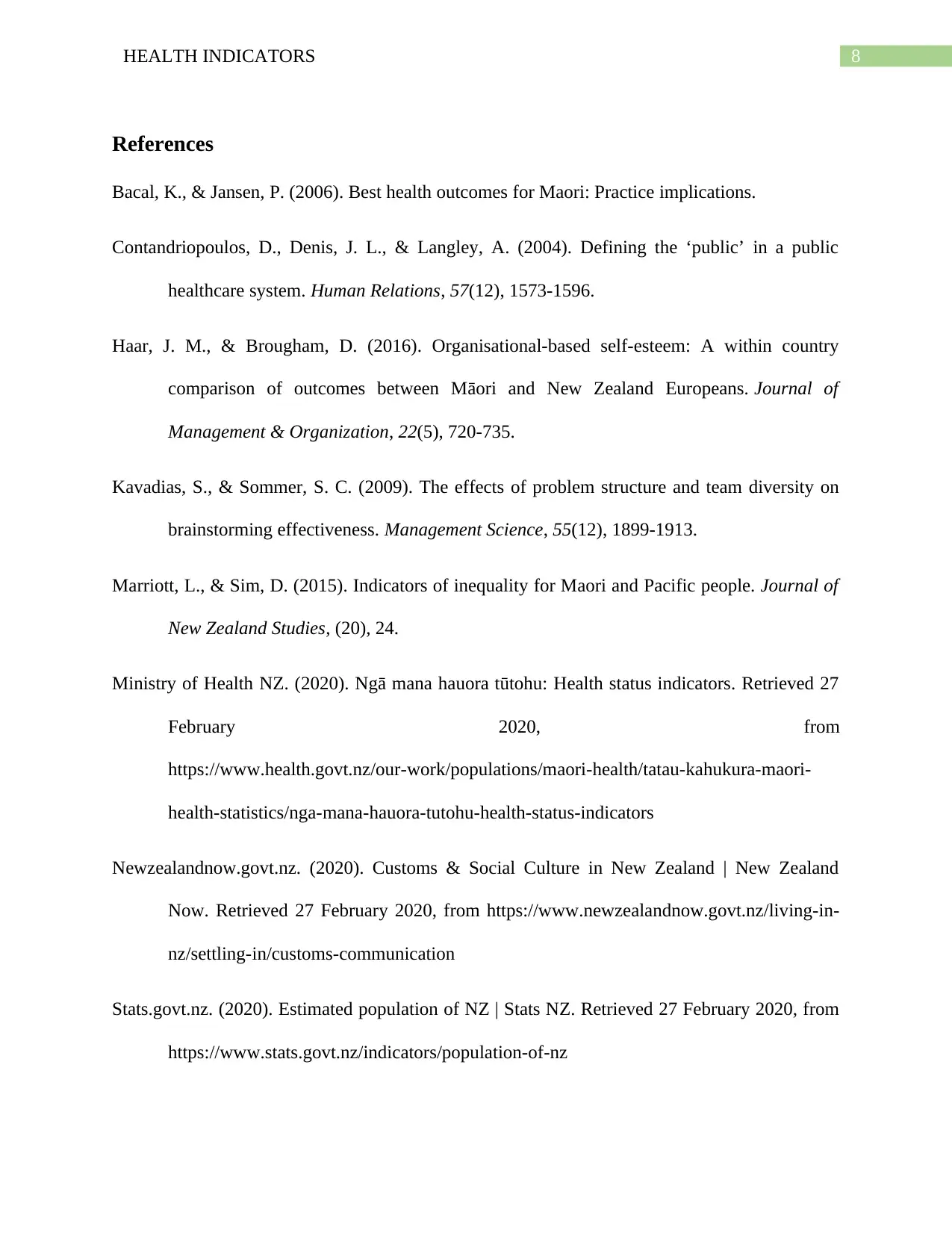
8HEALTH INDICATORS
References
Bacal, K., & Jansen, P. (2006). Best health outcomes for Maori: Practice implications.
Contandriopoulos, D., Denis, J. L., & Langley, A. (2004). Defining the ‘public’ in a public
healthcare system. Human Relations, 57(12), 1573-1596.
Haar, J. M., & Brougham, D. (2016). Organisational-based self-esteem: A within country
comparison of outcomes between Māori and New Zealand Europeans. Journal of
Management & Organization, 22(5), 720-735.
Kavadias, S., & Sommer, S. C. (2009). The effects of problem structure and team diversity on
brainstorming effectiveness. Management Science, 55(12), 1899-1913.
Marriott, L., & Sim, D. (2015). Indicators of inequality for Maori and Pacific people. Journal of
New Zealand Studies, (20), 24.
Ministry of Health NZ. (2020). Ngā mana hauora tūtohu: Health status indicators. Retrieved 27
February 2020, from
https://www.health.govt.nz/our-work/populations/maori-health/tatau-kahukura-maori-
health-statistics/nga-mana-hauora-tutohu-health-status-indicators
Newzealandnow.govt.nz. (2020). Customs & Social Culture in New Zealand | New Zealand
Now. Retrieved 27 February 2020, from https://www.newzealandnow.govt.nz/living-in-
nz/settling-in/customs-communication
Stats.govt.nz. (2020). Estimated population of NZ | Stats NZ. Retrieved 27 February 2020, from
https://www.stats.govt.nz/indicators/population-of-nz
References
Bacal, K., & Jansen, P. (2006). Best health outcomes for Maori: Practice implications.
Contandriopoulos, D., Denis, J. L., & Langley, A. (2004). Defining the ‘public’ in a public
healthcare system. Human Relations, 57(12), 1573-1596.
Haar, J. M., & Brougham, D. (2016). Organisational-based self-esteem: A within country
comparison of outcomes between Māori and New Zealand Europeans. Journal of
Management & Organization, 22(5), 720-735.
Kavadias, S., & Sommer, S. C. (2009). The effects of problem structure and team diversity on
brainstorming effectiveness. Management Science, 55(12), 1899-1913.
Marriott, L., & Sim, D. (2015). Indicators of inequality for Maori and Pacific people. Journal of
New Zealand Studies, (20), 24.
Ministry of Health NZ. (2020). Ngā mana hauora tūtohu: Health status indicators. Retrieved 27
February 2020, from
https://www.health.govt.nz/our-work/populations/maori-health/tatau-kahukura-maori-
health-statistics/nga-mana-hauora-tutohu-health-status-indicators
Newzealandnow.govt.nz. (2020). Customs & Social Culture in New Zealand | New Zealand
Now. Retrieved 27 February 2020, from https://www.newzealandnow.govt.nz/living-in-
nz/settling-in/customs-communication
Stats.govt.nz. (2020). Estimated population of NZ | Stats NZ. Retrieved 27 February 2020, from
https://www.stats.govt.nz/indicators/population-of-nz
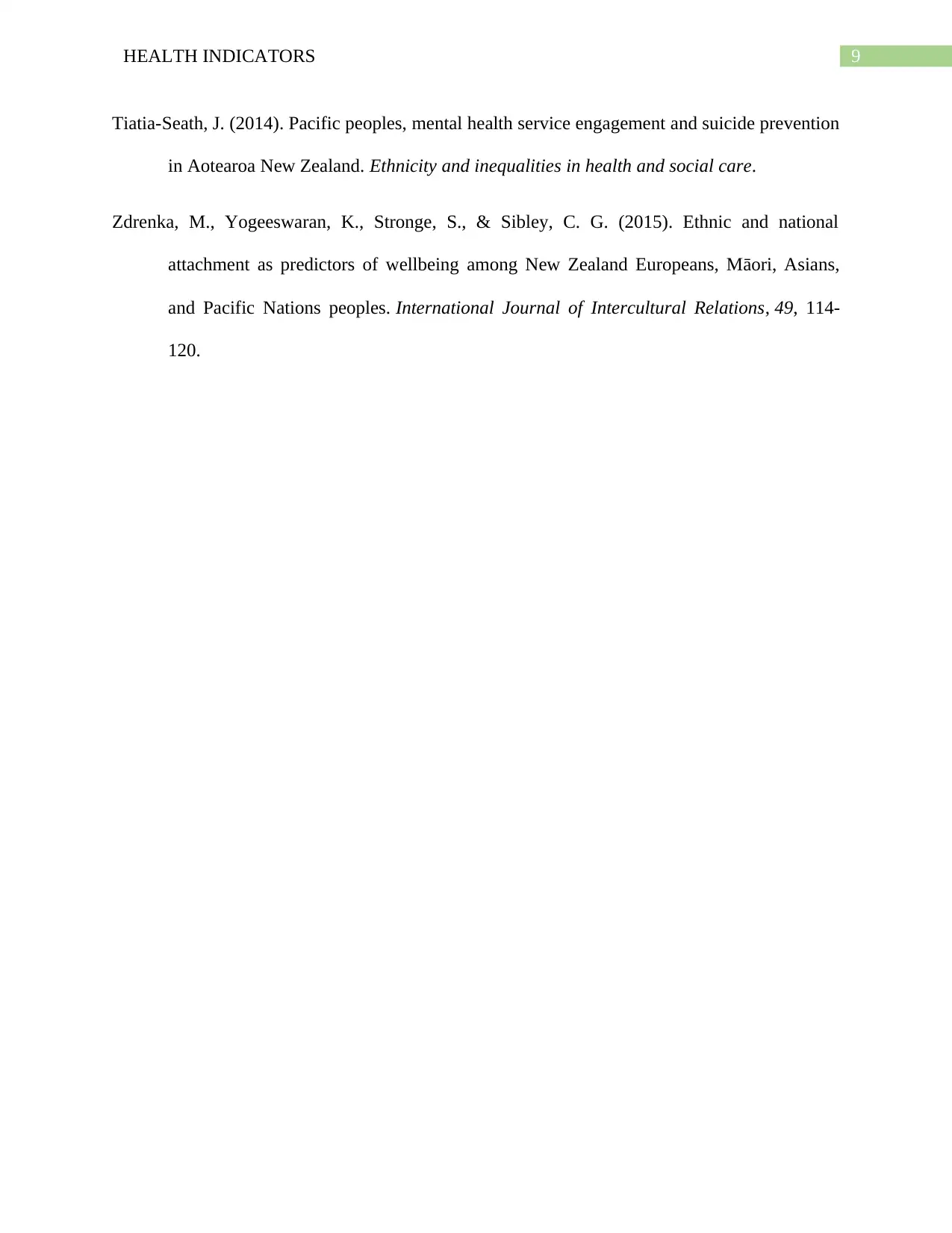
9HEALTH INDICATORS
Tiatia-Seath, J. (2014). Pacific peoples, mental health service engagement and suicide prevention
in Aotearoa New Zealand. Ethnicity and inequalities in health and social care.
Zdrenka, M., Yogeeswaran, K., Stronge, S., & Sibley, C. G. (2015). Ethnic and national
attachment as predictors of wellbeing among New Zealand Europeans, Māori, Asians,
and Pacific Nations peoples. International Journal of Intercultural Relations, 49, 114-
120.
Tiatia-Seath, J. (2014). Pacific peoples, mental health service engagement and suicide prevention
in Aotearoa New Zealand. Ethnicity and inequalities in health and social care.
Zdrenka, M., Yogeeswaran, K., Stronge, S., & Sibley, C. G. (2015). Ethnic and national
attachment as predictors of wellbeing among New Zealand Europeans, Māori, Asians,
and Pacific Nations peoples. International Journal of Intercultural Relations, 49, 114-
120.
1 out of 10
Related Documents
Your All-in-One AI-Powered Toolkit for Academic Success.
+13062052269
info@desklib.com
Available 24*7 on WhatsApp / Email
![[object Object]](/_next/static/media/star-bottom.7253800d.svg)
Unlock your academic potential
© 2024 | Zucol Services PVT LTD | All rights reserved.





